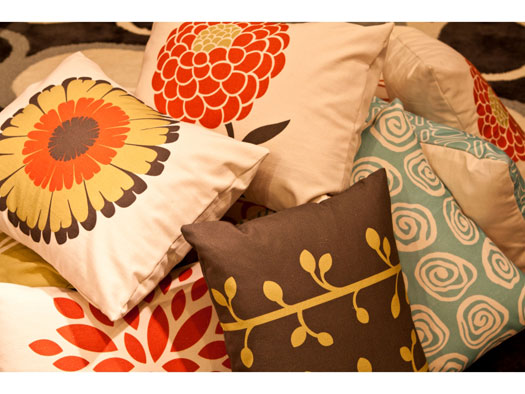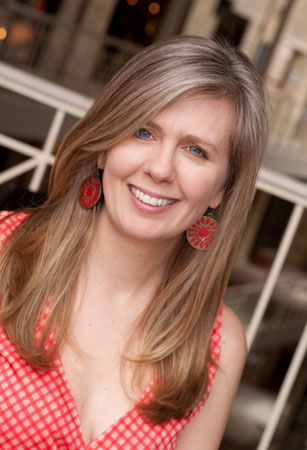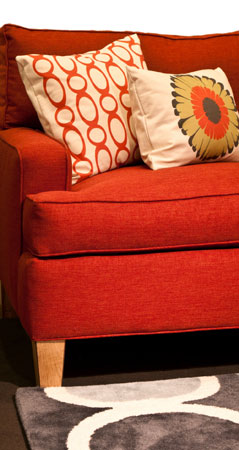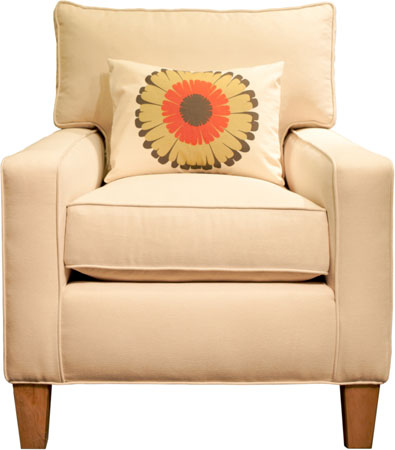We are never surprised that people have strong feelings about design. What does surprise us is when someone takes their love of design and changes careers completely to follow that passion. We recently spoke with Samantha Cobos of PURE Inspired; a line of eco-conscious fabrics and furnishings that she began in 2001.
We love that you just seemed to jump into eco-friendly fabrics and furnishings. How long were you designing before you decided to really take that plunge?
SC: Well, first of all I gave up my eight year career as a computer programmer to become an interior designer. I opened my own business in 2001 right after completing my design degree. I was successful, but the economy went south starting around 2008 and I had a lot of time on my hands. I started studying eco-friendly design as well as sketching patterns. What I discovered was a true passion for patterns and colors, as well as the need for eco-friendly design options! You might be surprised to know that I’m self-taught – I don’t take classes, I just try to figure things out on my own and I never give up 🙂
How did you become interested in eco-friendly design?
SC: I realized one day that my personal goals to be ‘green’ at home were not translating into my interior design business. Once I realized this I studied and read all I could on eco-friendly design choices. I also studied for the LEED AP test and passed!
You design eco-friendly furniture and fabrics. How would you describe your design style? Where are your products manufactured and how challenging is it to maintain control over the manufacturing process as it relates to sustainable manufacturing.
SC: I would describe my design style as fresh, fun, and easy. I don’t like stuffy interiors – I LOVE lived in spaces with splashes of color, lots of texture, and eye-catching patterns. I’m happy to say that all my furniture and fabrics are made in these! My furniture is manufactured in Minnesota, which is where I live. My organic fabric is grown, woven, and printed in the USA. I feel it is very important to keep things local whenever possible – it is less expensive to manufacture in China, but I wanted to keep everything close. The quality is better and the carbon footprint is smaller. Also keeping things close gives me more control – everything I manufacture is on demand so there is no inventory, which allows me to make changes and improvements easily.
You launched your line at the International Builder’s show – how nervous were you that your products would be reaching the right audience? Subsequent to that show – which trade shows do you exhibit at now – which ones do you consider your ‘must exhibit’ shows? And which trade shows do you attend to find out about the newest technologies and products?
SC: The interior designer for the green reVision home sponsored by Green Build Magazine, which was open during the International Builder’s Show, contacted me to see if I would be interested in participating in the home. I decided to dive right in and have products made for the show – the show really gave me the push and confidence that I needed. The audience for the show was not my ideal audience, they were mostly builder, but the experience was worth it! It was a lot of fun to be involved with the team and see my furniture, fabrics, and rug in a green home!
I have not been doing many trade shows since the IBS in 2010. I need to research the best shows for eco-friendly design products. In April I did the Greenprint show in St. Paul – it was a new show and I hope to be involved next year as well. With furniture it is very expensive to travel to other cities. I may do a textile show in the future, but I’m undecided.
Who or what has influenced you as a designer? Are there other ‘eco-conscious’ designers whose work you admire?
SC: When I started researching eco-friendly interior design I couldn’t find exactly what I was looking for and I found it frustrating. This is one of the reasons that I started creating my own patterns with custom colors. This gave me the flexibility to create whatever I was needing instead of just looking for it. I’m influenced more by colors and shapes – I never know where or when I will find a new inspiration – it just happens. I’m sure there are many wonderful eco-conscious designers out there, but my designs are inspired from everything I see whether it is interior design, fashion, gardening, architecture, pottery… then my own imagination creates something truly my own.
Ok – let’s go from the living room to the bathroom and talk a bit about the Caroma Challenge. You’ve reviewed Caroma’s water-saving Flow Showerhead on your blog. What struck you about that showerhead in comparison to other water saving products?
SC: I love the shape of the showerhead – it is sleek and different. The best thing about the showerhead is that it worked so well! Great shower experience and great water pressure! Plus it saves water – what could be better.
Do you think consumers know enough about how ‘easy’ it really can be to save water while still having a great shower experience? Would that be your biggest take-away from that challenge?
SC: I think I learned that it is so easy! People may think that it requires a plumber, but it was a 2 minute installation. So I think if consumers knew how easy it was to switch out their old shower head for a water-saving model they would do it.
How much of all of the information about sustainability in design is really trickling down (no pun intended) to the consumer now? What else can manufacturers or showrooms or designers do?
SC: I think education is the key. Once a consumer knows something about saving energy, water, the planet… they can’t just forget it and will try to make the best choices. Also consumers will share what they know with others. I’m always sharing interesting facts with people about the environment and good choices, and I have to believe that I’m making a difference!
Samantha Cobos, Allied ASID, LEED AP
PURE Inspired Design
Blog: PURE Inspired Design BLOG







